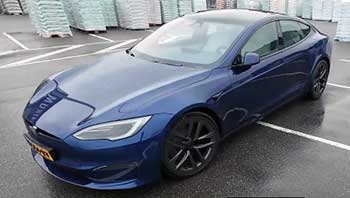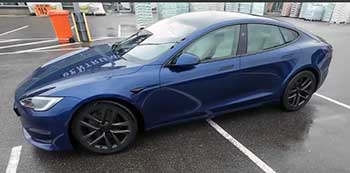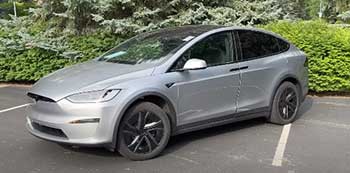
I’ve always been fascinated by Tesla’s ability to push the boundaries of electric vehicles, and the Model X is no exception.
As someone who’s spent time behind the wheel of both the Tesla Model X AWD and the Model X Plaid, I’m here to share a detailed comparison to help you decide which suits your needs.
This article breaks down their performance, features, pros, cons, and maintenance tips, all from my personal experience.
Whether you’re a speed enthusiast or seeking a practical luxury SUV, I’ll guide you through the key differences to make an informed choice.
Comparison Table
| Feature | Model X AWD | Model X Plaid |
|---|---|---|
| Price | $91,630 | $106,630 |
| Horsepower | 670 hp | 1,020 hp |
| 0-60 mph | 3.8 seconds | 2.5 seconds |
| Top Speed | 155 mph | 163 mph |
| Range | 352 miles | 335 miles |
| Drivetrain | Dual-motor AWD | Tri-motor AWD |
| Seating | 5, 6, or 7 seats | 6 seats standard |
| Towing Capacity | 5,000 lbs | 5,000 lbs |
| Cargo Space | 94.5 cu ft | 94.5 cu ft |
| Wheels | 20-inch standard | 20 or 22-inch |
| Interior Trim | Standard | Carbon fiber trim |
My Experience With Tesla Model X AWD
Driving the Tesla Model X AWD felt like stepping into a spaceship designed for families. The falcon-wing doors were a showstopper, swinging upward with a futuristic flair that turned heads at every school drop-off. Inside, the minimalist cabin, with its massive 17-inch touchscreen, made me feel like I was piloting a high-tech command center.
The 670 horsepower delivered a punchy 0-60 mph sprint in 3.8 seconds, which was more than enough to merge onto highways with confidence. The 352-mile range gave me peace of mind for weekend road trips, and the adaptive air suspension smoothed out bumpy roads, making long drives comfortable.
I loved how practical the AWD was for my family. The optional seven-seat configuration fit my kids and their gear, and the 94.5 cubic feet of cargo space swallowed up groceries, sports equipment, and even a stroller without breaking a sweat. The Autopilot features, like lane-keeping and adaptive cruise control, made highway driving less stressful, though I had to stay vigilant.
However, the yoke steering took some getting used to, and I occasionally missed the tactile feedback of a traditional wheel. Build quality was solid, but I noticed minor panel gaps that nagged at me for a vehicle in this price range.
Charging was straightforward with Tesla’s Supercharger network, though I learned to plan stops carefully on longer trips to avoid range anxiety. The Model X AWD’s efficiency, rated at 100 MPGe combined, kept my running costs low compared to gas-powered SUVs. Overall, it’s a versatile, luxurious ride that balances performance and practicality, perfect for those who want a premium EV without going overboard on speed.
Pros Of Tesla Model X AWD

- Impressive Range: The 352-mile range is among the best for electric SUVs, making it ideal for long trips without frequent charging stops.
- Family-Friendly Features: With seating for up to seven and 94.5 cubic feet of cargo space, it’s perfect for families or those needing extra room.
- Smooth Ride Quality: The adaptive air suspension absorbs road imperfections, ensuring a comfortable ride even on rough terrain.
- Advanced Technology: The 17-inch touchscreen and Autopilot features, like lane-keeping and adaptive cruise control, enhance the driving experience.
- Efficient Performance: With 670 horsepower and a 0-60 mph time of 3.8 seconds, it’s plenty fast for daily driving and highway merges.
- Access to Superchargers: Tesla’s extensive Supercharger network makes long-distance travel convenient and fast, with up to 200 miles of range added in 15 minutes.
- Lower Price Point: Starting at $91,630, it’s more affordable than the Plaid, offering great value for a luxury EV.
Read more: My Thoughts on Honda Odyssey Vs. Subaru Ascent
Cons Of Tesla Model X AWD
- Yoke Steering Challenges: The yoke can feel awkward, especially for tight maneuvers, and lacks the intuitive feel of a traditional wheel.
- Build Quality Issues: Minor panel misalignments and creaks in the cabin can detract from the premium experience.
- Charging Time: While Superchargers are fast, home charging on a 120-volt outlet is slow, requiring a 240-volt setup for practicality.
- Limited Off-Road Capability: Despite AWD, the low ground clearance and road-focused tires limit its ability to tackle rugged terrain.
- Complex Interface: The touchscreen controls everything, which can be distracting when adjusting climate or media on the go.
- High Initial Cost: At $91,630, it’s still a significant investment, especially when adding options like Full Self-Driving for $15,000.
- Third-Row Tightness: The optional third row is cramped for adults, better suited for children or occasional use.
Maintenance Tips For Tesla Model X AWD
- Regular Tire Checks: Rotate tires every 6,000 miles to ensure even wear, as the AWD’s power can stress tires, especially during spirited driving.
- Cabin Air Filter Replacement: Replace the cabin air filter every two years to maintain air quality and HVAC efficiency.
- Wiper Blade Maintenance: Inspect and replace wiper blades annually, as the Model X’s large windshield needs clear visibility in all weather.
- Software Updates: Keep the vehicle’s software updated via Tesla’s over-the-air updates to access new features and performance enhancements.
- Battery Health Monitoring: Avoid letting the battery drop below 20% regularly; charge to 80-90% for daily use to prolong battery life.
- Clean Sensors Regularly: Wipe down Autopilot sensors and cameras to ensure driver-assistance features function accurately.
- Check Brake Fluid: Though EVs use regenerative braking, check brake fluid levels every two years to prevent issues with the hydraulic system.
My Experience With Tesla Model X Plaid
The Tesla Model X Plaid is a beast that redefined what I thought an SUV could do. From the moment I floored the accelerator, the 1,020 horsepower and tri-motor setup launched me to 60 mph in a mind-bending 2.5 seconds.
It’s not just fast—it’s supercar territory, leaving me grinning like a kid every time I unleashed its power. The carbon fiber interior trim and pinstripe seats added a sporty edge to the cabin, and the falcon-wing doors never failed to impress onlookers. The 17-inch touchscreen was as responsive as ever, and the new ambient lighting made nighttime drives feel like a sci-fi movie.
However, the Plaid’s 335-mile range was slightly less than the AWD’s, which meant more frequent charging stops on long trips. The 22-inch wheels looked stunning but made the ride firmer, especially on rough roads. I also found the six-seat configuration less flexible for larger groups, as the Plaid doesn’t offer a seven-seat option.
The yoke steering was even more polarizing here, as the Plaid’s speed demanded precise control, and I occasionally fumbled during quick turns. Despite these quirks, the Plaid’s raw performance and cutting-edge tech made every drive an event, though its $106,630 price tag reflects that thrill.
The Plaid’s towing capacity matched the AWD at 5,000 pounds, but I rarely used it, as this model felt more suited to drag strips than hauling trailers. The Autopilot and optional Full Self-Driving package worked well, but I noticed the same build quality niggles as in the AWD. For speed enthusiasts, the Plaid is unmatched, but it’s overkill for everyday driving unless you crave that adrenaline rush.
Read more: My Thoughts on GMC Terrain Vs. Ford Escape
Pros Of Tesla Model X Plaid
- Unrivaled Acceleration: The 2.5-second 0-60 mph time and 1,020 horsepower make it one of the fastest SUVs on the planet.
- Premium Interior Accents: Carbon fiber trim and pinstripe seats elevate the cabin’s sporty, luxurious feel.
- Advanced Torque Vectoring: The tri-motor setup enhances handling, providing better grip during high-speed cornering.
- Impressive Tech Suite: The 17-inch touchscreen, ambient lighting, and rear-seat climate controls create a futuristic driving experience.
- Supercharger Access: Like the AWD, it benefits from Tesla’s fast-charging network, adding up to 200 miles in 15 minutes.
- Track-Ready Performance: Larger brakes and performance tires make it more capable for spirited driving or track days.
- Exclusive Appeal: The Plaid badge and tri-motor setup offer a unique status symbol among Tesla models.
Cons Of Tesla Model X Plaid

- Higher Price Tag: At $106,630, it’s significantly more expensive than the AWD, which may not justify the performance for all buyers.
- Reduced Range: The 335-mile range is shorter than the AWD’s, requiring more frequent charging on long trips.
- Firm Ride Quality: The 22-inch wheels and sport-tuned suspension make the ride less comfortable on rough roads.
- Limited Seating Options: Only available in a six-seat configuration, reducing flexibility for larger families.
- Yoke Steering Issues: The yoke is harder to manage at high speeds, where precision is critical.
- Build Quality Concerns: Like the AWD, minor panel gaps and interior creaks can feel out of place for the price.
- Overkill for Daily Use: The extreme performance is rarely needed for commuting or errands, making it less practical.
Maintenance Tips For Tesla Model X Plaid
- Tire Rotation and Alignment: Rotate tires every 5,000 miles due to the Plaid’s high torque, and check alignment to prevent uneven wear.
- Brake System Inspection: Inspect brakes annually, as the Plaid’s larger brakes endure more stress during aggressive driving.
- Software Updates: Regularly install Tesla’s over-the-air updates to optimize performance and fix potential bugs.
- Battery Care: Charge to 80% for daily use and avoid frequent full discharges to maintain battery health.
- Clean Autopilot Sensors: Keep cameras and sensors free of dirt to ensure accurate performance of driver-assistance features.
- Monitor Suspension: Check the adaptive air suspension for wear, especially if driving on 22-inch wheels over rough roads.
- Wiper Maintenance: Replace wiper blades every 6-12 months to maintain visibility, given the Plaid’s high-speed capabilities.
Frequently Asked Questions (FAQ)
The Model X AWD uses a dual-motor setup with 670 horsepower, a 3.8-second 0-60 mph time, and a 352-mile range. The Plaid has a tri-motor setup, 1,020 horsepower, a 2.5-second 0-60 mph time, and a 335-mile range. The Plaid also includes carbon fiber trim and is limited to a six-seat configuration.
The Model X Plaid is the fastest, with a 0-60 mph time of 2.5 seconds and a top speed of 163 mph, compared to the AWD’s 3.8 seconds and 155 mph.
The Model X Plaid is an SUV with up to seven seats, 94.5 cubic feet of cargo, and a 335-mile range. The Model S Plaid is a sedan with five seats, less cargo space, and a 396-mile range. The S Plaid is faster (1.99 seconds 0-60 mph) but less practical for families.
Look for the “Plaid” badge on the rear, carbon fiber interior trim, and pinstripe seats. The Plaid is only available in a six-seat configuration and has a tri-motor drivetrain, which you can confirm via the vehicle’s touchscreen or Tesla’s website.
Conclusion: For Tesla Model X AWD And Plaid
Choosing between the Tesla Model X AWD and Plaid depends on what you value most. If you’re after a practical, family-friendly SUV with excellent range and solid performance, the AWD’s 352 miles and $91,630 price tag make it a smart pick.
If speed is your passion, the Plaid’s 2.5-second 0-60 mph sprint and 1,020 horsepower are unbeatable, though its $106,630 cost and shorter range might give you pause. Both offer cutting-edge tech and Tesla’s Supercharger network, but the AWD balances versatility and value, while the Plaid is a thrill-seeker’s dream. Test drive both to feel the difference and decide what fits your lifestyle.

